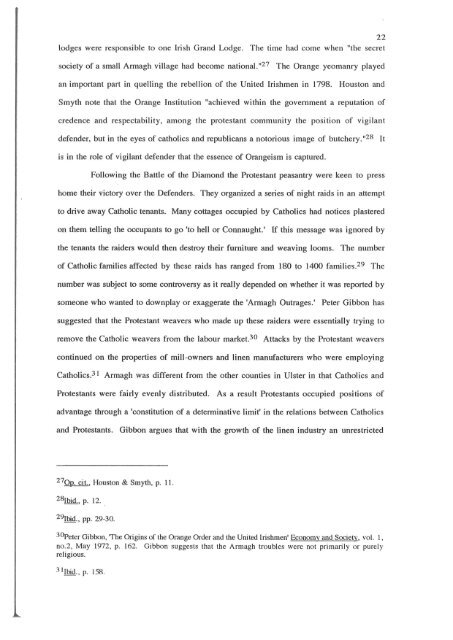TRANSPLANTED IRISH INSTITUTIONS - University of Canterbury
TRANSPLANTED IRISH INSTITUTIONS - University of Canterbury
TRANSPLANTED IRISH INSTITUTIONS - University of Canterbury
You also want an ePaper? Increase the reach of your titles
YUMPU automatically turns print PDFs into web optimized ePapers that Google loves.
22<br />
lodges were responsible to one Irish Grand Lodge. The time had come when "the secret<br />
society <strong>of</strong> a small Armagh village had become national. "27 The Orange yeomanry played<br />
an important part in quelling the rebellion <strong>of</strong> the United Irishmen in 1798. Houston and<br />
Smyth note that the Orange Institution "achieved within the government a reputation <strong>of</strong><br />
credence and respectability, among the protestant community the position <strong>of</strong> vigilant<br />
defender, but in the eyes <strong>of</strong> catholics and republicans a notorious image <strong>of</strong> butchery ."28 It<br />
is in the role <strong>of</strong> vigilant defender that the essence <strong>of</strong> Orangeism is captured.<br />
Following the Battle <strong>of</strong> the Diamond the Protestant peasantry were keen to press<br />
home their victory over the Defenders. They organized a series <strong>of</strong> night raids in an attempt<br />
to drive away Catholic tenants. Many cottages occupied by Catholics had notices plastered<br />
on them telling the occupants to go 'to hell or Connaught.' If this message was ignored by<br />
the tenants the raiders would then destroy their furniture and weaving looms. The number<br />
<strong>of</strong> Catholic families affected by these raids has ranged from 180 to 1400 families. 29 The<br />
number was subject to some controversy as it really depended on whether it was reported by<br />
someone who wanted to downplay or exaggerate the 'Armagh Outrages.' Peter Gibbon has<br />
suggested that the Protestant weavers who made up these raiders were essentially trying to<br />
remove the Catholic weavers from the labour market. 30 Attacks by the Protestant weavers<br />
continued on the properties <strong>of</strong> mill-owners and linen manufacturers who were employing<br />
Catholics. 31 Armagh was different from the other counties in Ulster in that Catholics and<br />
Protestants were fairly evenly distributed. As a result Protestants occupied positions <strong>of</strong><br />
advantage through a 'constitution <strong>of</strong> a determinative limit' in the relations between Catholics<br />
and Protestants. Gibbon argues that with the growth <strong>of</strong> the linen industry an unrestricted<br />
27Op. cit., Houston & Smyth, p. 11.<br />
28Ibid., p. 12 . .<br />
29Jbid., pp. 29-30.<br />
30peter Gibbon, The Origins <strong>of</strong> the Orange Order and the United Irishmen' Economy and Society, vol. I,<br />
no.2, May 1972, p. 162. Gibbon suggests that the Armagh troubles were not primarily or purely<br />
religious.<br />
31Ibid.,p.I58.
















